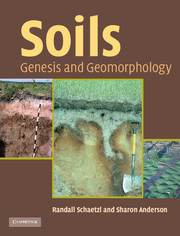Book contents
- Frontmatter
- Contents
- Preface
- Acknowledgements
- Part I The building blocks of the soil
- Part II Soil genesis: from parent material to soil
- Part III Soil geomorphology
- 13 Soil geomorphology and hydrology
- 14 Soil development and surface exposure dating
- 15 Soils, paleosols and paleoenvironmental reconstruction
- 16 Conclusions and Perspectives
- References
- Glossary
- Index
15 - Soils, paleosols and paleoenvironmental reconstruction
from Part III - Soil geomorphology
- Frontmatter
- Contents
- Preface
- Acknowledgements
- Part I The building blocks of the soil
- Part II Soil genesis: from parent material to soil
- Part III Soil geomorphology
- 13 Soil geomorphology and hydrology
- 14 Soil development and surface exposure dating
- 15 Soils, paleosols and paleoenvironmental reconstruction
- 16 Conclusions and Perspectives
- References
- Glossary
- Index
Summary
A palimpsest (Latin palimpsestus, scraped again) is a parchment that has been used one or more times after earlier writings have been erased. Recently erased passages are not that difficult to make out, as erasures are rarely complete. Previous, older passages on the palimpsest are much more difficult, but not impossible, to read and interpret. It simply takes skill and patience. In this chapter we provide information on the interpretation of pedo-palimpsests, i.e., soils. Each and every soil (except for the very youngest ones) is a palimpsest that has information written on it; interpreting it is an exciting challenge and an important application of soil geomorphology (Catt 1990). The information on pedo-palimpsests is usually indicative of past landscape change, whether that change refers to climate, vegetation or geomorphology.
Soil morphology and chemistry are all influenced by the various soil-forming factors. In this chapter we discuss how a careful “reading” of soils as palimpsests, coupled with a knowledge of how soil development is related to contemporary soil-forming processes, can often (for older soils) provide a wealth of information about conditions associated with periods in the geologic past. This chapter must follow chapters on soil genesis, weathering, pedoturbation, parent materials and geomorphology, for the type of paleopedologic, paleoclimatic and paleogeomorphic interpretations we discuss require a thorough knowledge of all these facets of soil geomorphology. Our approach involves, at a minimum, these two questions.
- Type
- Chapter
- Information
- SoilsGenesis and Geomorphology, pp. 619 - 652Publisher: Cambridge University PressPrint publication year: 2005
- 1
- Cited by



